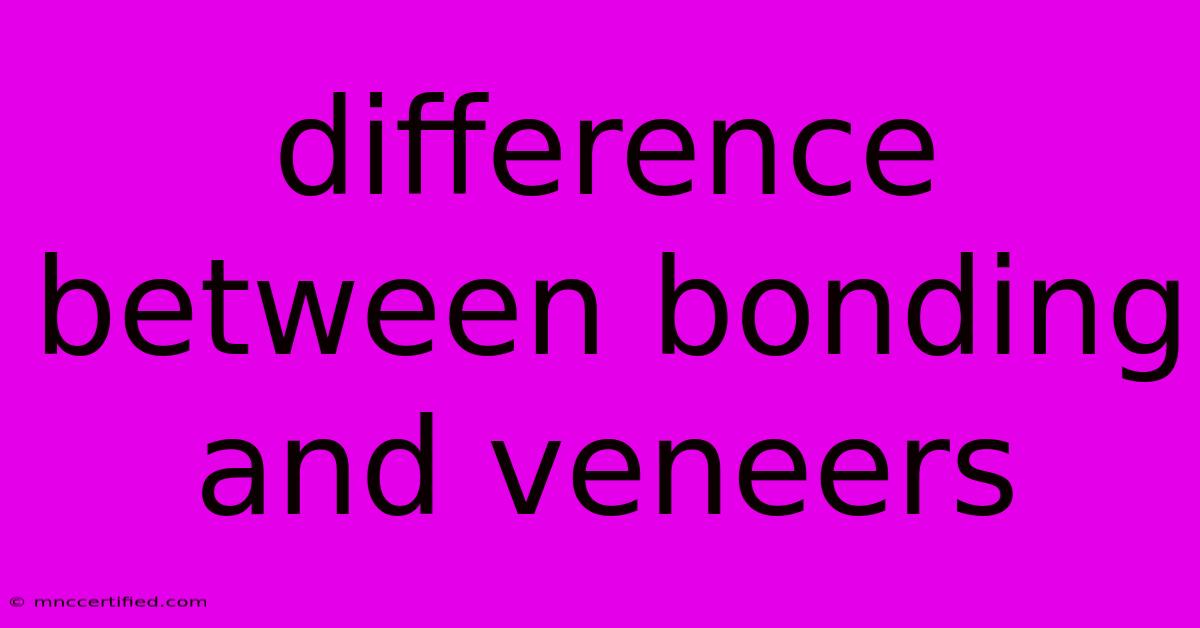Difference Between Bonding And Veneers

Table of Contents
Bonding vs. Veneers: Which is Right for You?
If you're looking to improve your smile, you've likely come across two popular options: dental bonding and veneers. Both procedures can address a variety of cosmetic concerns, but they have distinct differences in their application, materials, and overall effects. This article will delve into the key differences between bonding and veneers, helping you make an informed decision about the best treatment for your needs.
What is Dental Bonding?
Dental bonding is a conservative and versatile cosmetic procedure that uses a tooth-colored composite resin to repair and enhance the appearance of teeth. The resin is applied directly to the tooth, shaped and sculpted, then hardened with a special light. Bonding can address a range of issues, including:
- Chipped or broken teeth: Bonding can seamlessly fill in gaps and create a smooth, natural-looking surface.
- Discolored teeth: Bonding can cover stains and create a brighter, more even shade.
- Gaps between teeth: Bonding can close small gaps and improve the overall aesthetic.
- Uneven tooth shapes: Bonding can reshape and contour teeth to achieve a more symmetrical smile.
What are Veneers?
Veneers are thin, custom-made shells of porcelain or composite material that are bonded to the front surface of teeth. They are designed to cover the entire front of the tooth, completely altering its appearance. Veneers are known for their:
- Durable and stain-resistant nature: Porcelain veneers are extremely resistant to staining, maintaining their bright color over time.
- Natural-looking results: Veneers can mimic the natural translucency of teeth, creating a highly aesthetic outcome.
- Ability to address complex issues: Veneers can correct a wider range of imperfections than bonding, including severe discoloration, misalignment, and large gaps.
Bonding vs. Veneers: Key Differences
Here's a table outlining the key differences between bonding and veneers:
| Feature | Dental Bonding | Veneers |
|---|---|---|
| Material | Composite resin | Porcelain or composite |
| Procedure | Direct application and sculpting | Custom-made and bonded |
| Durability | Less durable than veneers | More durable than bonding |
| Cost | More affordable | More expensive |
| Maintenance | Requires regular check-ups and touch-ups | Requires less maintenance than bonding |
| Time commitment | Single appointment | Multiple appointments |
| Suitable for: | Minor imperfections, tooth reshaping, small gaps | Severe discoloration, misalignment, large gaps, worn teeth |
Which is Right for You?
Ultimately, the best choice depends on your individual needs and preferences. Consider these factors:
- Severity of the issue: If you have minor imperfections like chips or slight discoloration, bonding might be a suitable option. For more complex problems, veneers may be the better choice.
- Budget: Bonding is generally less expensive than veneers.
- Aesthetic goals: Veneers offer a more dramatic transformation and a longer-lasting result, while bonding provides a more conservative approach.
- Lifestyle: If you're prone to staining or have a demanding lifestyle, veneers might be a better investment due to their durability and stain resistance.
Choosing the Right Dentist
It's crucial to consult with a qualified and experienced cosmetic dentist to determine the best treatment option for you. They can assess your specific needs, explain the pros and cons of each procedure, and help you make an informed decision.
Remember, your smile is a reflection of your overall health and confidence. By understanding the differences between bonding and veneers, you can make the best choice to achieve the beautiful, healthy smile you deserve.

Thank you for visiting our website wich cover about Difference Between Bonding And Veneers. We hope the information provided has been useful to you. Feel free to contact us if you have any questions or need further assistance. See you next time and dont miss to bookmark.
Featured Posts
-
Health Insurance Broker West Palm Beach
Nov 09, 2024
-
Members Insurance Company Phone Number
Nov 09, 2024
-
Unexpected Brain Tumor Found After Stress Symptoms
Nov 09, 2024
-
Supermodel Georgina Cooper Passes Away At 46
Nov 09, 2024
-
How Many Pi Bonds Are In This Molecule
Nov 09, 2024